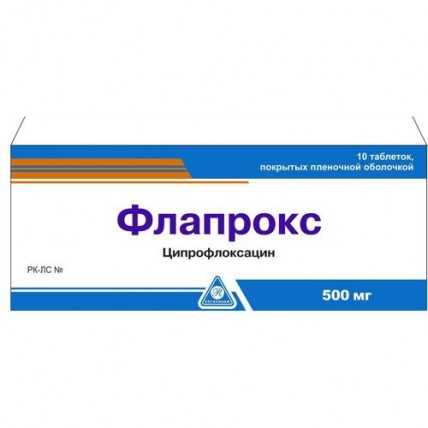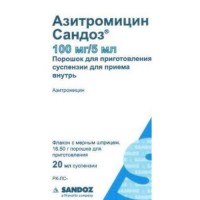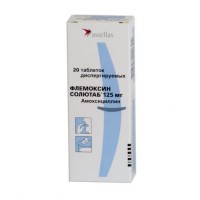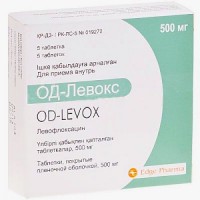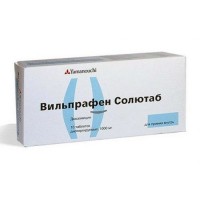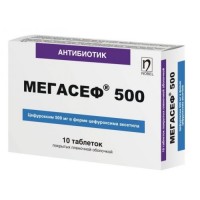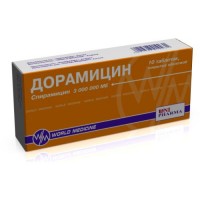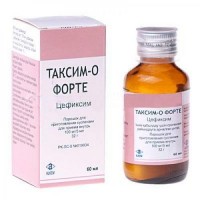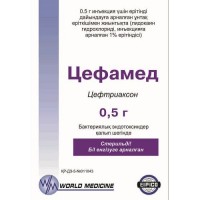Flaproks 10s 500 mg film-coated tablets
- $10.30
The instruction for medical use
of FLAPROKS medicine
the Trade name
of Flaproks
the International unlicensed
name Ciprofloxacin Dosage Form
of the Tablet, film coated 500 mg
Structure
One tablet contains
active agent - ciprofloxacin of 500 mg
(in the form of a monohydrate hydrochloride (582 mg)),
excipients: cellulose microcrystalline (Avitsel rn101), starch corn, krospovidon, sodium of a kroskarmelloz, silicon dioxide colloidal anhydrous (Aerosil 200), magnesium stearate.
cover of Opadri white (Y-1-7000): hydroksipropilmetiltsellyuloza, titan dioxide (E171), polyethyleneglycol 400.
The description
of the Tablet of round shape, a biconvex surface, film coated white color, with risky on one party.
Pharmacotherapeutic group
Antibacterial agents for system use.
Antimicrobial drugs – derivatives of a ftorkhinolon.
Ftorkhinolona.
The ATX J01MA02 code
the Pharmacological
Pharmacokinetics At properties oral administration of ciprofloxacin is quickly and rather fully soaked up from zheludochno – an intestinal path (mainly in 12 – perstny and a jejunum). Meal slows down absorption, but does not change the maximum concentration (Cmax) and bioavailability.
Bioavailability – 50 – 85%, distribution volume – 2-3.5 l/kg, communication with proteins of blood plasma – 20-40%. Time of achievement of the maximum concentration (TCmax) at oral administration – 60-90 min., Cmax linearly depends on the size of the accepted dose and is at doses 250 and 500 mg respectively of 1.2 and 2.4 mkg/ml. In 12 h after intake of 250 and 500 mg the concentration of drug in plasma decreases to 0.1 and 0.2 mkg/ml respectively.
Ciprofloxacin is well distributed in body tissues (excepting the fabric rich with fats, for example, nervous tissue). Concentration in fabrics is 2-12 times higher, than in plasma. Therapeutic concentration are reached in saliva, tonsils, a liver, a gall bladder, bile, intestines, abdominal organs and a small pelvis (endometrium, fallopian pipes, ovaries and a uterus), semen, prostate tissue, kidneys and urinary bodies, pulmonary fabric, a bronchial secret, a bone tissue, muscles, synovial fluid and articulate cartilages, peritoneal liquid, skin. Gets into cerebrospinal fluid (SMZh) in a small amount where its concentration in the absence of inflammation of a meninx makes 6-10% of that in blood serum, and at inflamed – 14-37%.
Ciprofloxacin well gets also into eye liquid, a bronchial secret, a pleura, a peritoneum, a lymph, through a placenta. Concentration of ciprofloxacin in neutrophils of blood is 2-7 times higher, than in blood serum.
The activity decreases at values rn less than 6 a little.
Ciprofloxacin is metabolized in a liver (15-30%) with formation of low-active metabolites (diethylciprofloxacin, sulfociprofloxacin, oxociprofloxacin, formylciprofloxacin).
Elimination half-life (T1/2) – about 4 h, in the chronic kidney disease (CKD) – up to 12 h. The rest – through zheludochno – an intestinal path is removed generally by kidneys by canalicular filtration and canalicular secretion in an invariable look (40-50%) and in the form of metabolites (15%). A small amount is removed with breast milk.
Renal clearance – 3-5 ml/min., the general clearance – 8-10 ml/min. At HNP (chronic renal insufficiency) (the clearance of creatinine (CC) is higher than 20 ml/min.) the percent of the drug removed through kidneys decreases, but cumulation in an organism does not happen owing to compensatory increase in metabolism of drug and removal through zheludochno – an intestinal path.
The pharmacodynamics
of Flaproks – antimicrobial drug of a broad spectrum of activity, derivative quinoline, suppresses bacterial DNK-girazu (topoisomerases II and IV responsible for process of superspiralling of chromosomal DNA around nuclear RNA that is necessary for reading of genetic information), breaks DNA synthesis, growth and division of bacteria, causes the significant morphological changes (including. cell wall and membranes) and fast death of a bacterial cell.
Affects bakteritsidno gram-positive organisms during a dormant period and divisions (since influences not only DNA – a giraza, but also causes lysis of a cell wall), on gram-positive microorganisms – only in elimination half-life.
The hypotoxicity for cells of a macroorganism is explained by absence in them DNK-girazy. Against the background of Flaproks's reception there is no parallel development of resistance to other antibiotics which are not belonging to group of inhibitors of a giraza that does it highly effective in relation to bacteria which are steady, for example to aminoglycosides, penicillin, cephalosporins, tetracyclines and many other antibiotics.
Gram-negative aerobic bacteria are sensitive to Flaproks:
enterobakteriya (Escherichia coli, Salmonella spp., Shigella spp., Citrobacter spp., Klebsiella spp., Enterobacter spp., Proteus mirabilis, Proteus vulgaris, Serratia marcescens, Hafnia alvei, Edwardsiella tarda, Providencia spp., Morganella morganii, Vibrio spp., Yersinia spp.), other gram-negative bacteria (Haemophilus spp., Pseudomonas aeruginosa, Moraxella catarrhalis, Aeromonas spp., Pasteurella multtocida, Plesiomonas shigelloides, Campylobacter jejuni, Neisseria spp.), some intracellular activators - Legionella pneumophila, Brucella spp., Listeria monocytogenes, Mycobacterium tuberculosis, Mycrobacterium kansasii, gram-positive aerobic bacteria: Staphylococcus spp. (Staphylococcus aureus, Staphylococcus haemolyticus, Staphylococcus hominis, Staphylococcus saprophyticus), Staphylococcus spp. (Streptococcus reptococcus pyogenes, Streptococcus agalactiae). It is active concerning Bacillus anthracis in vitro.
The majority of the stafilokkok resistant to Methicillinum, rezistentna and to ciprofloxacin. Sensitivity of Streptococcus pneumonia, Enterococcus faecalis, Mycobacterium avium (located intracellularly) – moderated (for their suppression high concentrations are required).
To rezistentna drug: Bacteroides fragilis, Pseudomonas cepacia, Pseudomonas maltophila, Ureaplasma urealyticum, Clostridium difficile, Nocardia asteroids. It is not effective concerning Treponema pallidum.
The resistance develops extremely slowly as, on the one hand, after Flaproks's action there is practically no persistent microorganism left, and with another – bacterial cells have no enzymes inactivating it.
Indications
- sharp and chronic (in an aggravation stage) bronchitis, pneumonia, a bronchoectatic disease, infectious complications of a mucoviscidosis
- acute sinusitis
- cystitis, pyelonephritis
- the complicated intraabdominal infections (in a combination with metronidazole)
- chronic bacterial prostatitis
- uncomplicated gonorrhea
- a typhoid, campylobacteriosis, a shigellosis, diarrhea of travellers
- the infected ulcers, wounds, burns, abscesses, phlegmon
- osteomyelitis, septic arthritis
- infections against the background of the immunodeficiency (which arose at treatment by immunosuppressive medicines or at patients with a neutropenia)
- prevention and treatment of an inhalation anthrax (infection of Bacillus anthracis)
the Route of administration and doses
Inside. Tablets should be swallowed entirely with a small amount of liquid after a meal. At reception of a tablet on an empty stomach active agent is soaked up quicker.
In lower respiratory tract infections easy and moderately severe – 0.5 g 2 times a day, at a heavy course – 0.75 g 2 times a day. A course of treatment – 7-14 days.
In acute sinusitis – on 0.5 g 2 times a day. A course of treatment – 10 days.
In an infection of skin and soft tissues of easy and average degree – 0.5 g 2 times a day, at a heavy course – 0.75 g 2 times a day. A course of treatment – 7-14 days.
In infections of bones and joints of easy and average degree – 0.5 g 2 times a day, at a heavy course – 0.75 g 2 times a day. A course of treatment – up to 4-6 weeks.
In infections of urinary tract – on 0.25-0.5 g 2 times a day, a course of treatment – 7-14 days, in uncomplicated cystitis at women – 3 days.
In chronic bacterial prostatitis – on 0.5 g 2 times a day, a course of treatment – 28 days.
In uncomplicated gonorrhea – 0.25-0.5 g once.
Infectious diarrhea – on 0.5 g 2 times a day, a course of treatment – 5-7 days.
In a typhoid – on 0.5 g 2 times a day, a course of treatment – 10 days.
At the complicated intraabdominal infections – on 0.5 g each 12 h within 7-14 days.
For prevention and treatment of an inhalation anthrax – on 0.5 g 2 times a day within 60 days.
HPN: at KK more than 50 ml/min. dose adjustment is not required, at KK of 30-50 ml/min. – 0.25-0.5 g each 12 h, at KK of 5-29 ml/min. – 0.25-05 each 18 h. If to the patient the hemodialysis or peritoneal dialysis – 0.25-05 g/days is carried out, but it is necessary to accept after the hemodialysis session.
Side effects
Often:
- nausea, diarrhea
Sometimes:
- vomiting, an abdominal pain, a loss of appetite
- dizziness, a headache, increased fatigue, uneasiness
- disturbance of taste and sense of smell
- a leukopenia
Seldom:
- a meteorism
- tachycardia, disturbances of a warm rhythm
- thrombocytopenia
- a prothrombinopenia, increase in activity of hepatic transaminases and alkaline phosphatase
- pain in a breast
- a myocardial infarction
Very seldom
- cholestatic jaundice (especially at patients with the postponed liver diseases), hepatitis, gepatonekroz
- pancreatitis
- a tremor, insomnia, dreadful dreams, a peripheral paralgeziya (anomaly of perception of feeling of pain), perspiration, increase in intracranial pressure, uneasiness, confusion of consciousness, a depression, hallucinations and also other manifestations of psychotic reactions (which are occasionally progressing to a state in which the patient can do himself harm), migraine, unconscious states
- paranoia
- an ataxy
- spasms
- a phobia
- a disorder of vision (a diplopia, change a svetovospriyatiya), sonitus, decrease in hearing
- a lowering of arterial pressure, thrombosis of cerebral arteries
- a granulocytopenia, anemia, a leukocytosis, a thrombocytosis, hemolytic anemia
- a giperkreatininemiya, a hyperbilirubinemia, a hyperglycemia
- gastro intestinal perforation of intestines
- gastrointestinal bleedings
- a renal failure
- a hamaturia, a crystalluria (first of all at alkalinuria and a hypouresis), a glomerulonephritis, a dysuria, a polyuria, an ischuria, an albuminuria, urethral bleedings, a hamaturia, decrease in azotvydelitelny function of kidneys, interstitial nephrite
- allergic reactions: sometimes – a skin itching, it is rare – urticaria, a face edema or throats, is very rare – formation of the blisters which are followed by bleedings and emergence of the small small knots forming crusts, medicinal fever, dot hemorrhages on skin (petechia), short wind, an eosinophilia, a vasculitis, a nodal erythema, a multiformny exudative erythema (including Stephens's syndrome – Johnson), a toxic epidermal necrolysis (Lyell's disease)
- other: the asthenia, the increased photosensitivity, superinfections (candidiasis, pseudomembranous colitis), inflows of blood to the person, the increased sweating, an arthralgia, arthritis, a tendovaginitis, ruptures of sinews, myalgia
- the obscured sight, a diplopia
- a pneumorrhagia
- a bronchospasm
- a Quincke's disease
- a ring in ears
-
Contraindication fever
- increases sensitivity to ciprofloxacin or other drugs from
group of ftorkhinolon
- a concomitant use with tizanidiny and theophylline (risk of the profound lowering of arterial pressure, drowsiness)
- pregnancy and the period of a lactation
- a lactose intolerance
- insufficiency of lactase
- glucose – galaktozny malabsorption
- children's and teenage age up to 18 years
Medicinal interactions
Owing to decrease of the activity of processes of microsomal oxidation in hepatocytes of Flaproks increases concentration and extends theophylline T1/2 (and other xanthines, for example, caffeine), oral hypoglycemic medicines, antikoagulyany means of indirect action, promotes decrease in the prothrombin ratio.
At a combination to other antimicrobial HP (a beta – laktamny antibiotics, aminoglycosides, clindamycin, metronidazole) synergism is usually observed, it is possible to apply in a combination with azlotsilliny and a ceftazidime in the infections caused by Pseudomonas spp. with mezlotsilliny, azlotsilliny and others a beta – laktamny antibiotics – at streptococcal infections, with izoksazolilpenitsillina and Vancomycinum – in staphylococcal infections, with mentonidazoly and clindamycin – in mephitic gangrenes.
Flaproks strengthens nephrotoxic effect of cyclosporine, increase in serumal creatinine is noted, at such patients the control of this indicator 2 times a week is necessary.
At a concomitant use strengthens action of anticoagulating means of indirect action.
Oral administration together with ferriferous HP, sukralfaty and the antiacid HP containing ions of magnesium, calcium and aluminum leads to decrease in absorption of Flaproks therefore it is necessary to appoint it for 1-2 h to or in 4 h after reception of the above-stated HP.
Non-steroidal anti-inflammatory drugs (excepting acetilsalicylic acid) increase risk of developing spasms.
Didanozin reduces Flaproks's absorption owing to formation of complexes with ions of aluminum and magnesium contained in the didanozena.
Metoclopramidum accelerates Flaproks's absorption that leads to reduction of time of achievement of its Cmax.
Combined use of uricosuric HP leads to removal delay (up to 50%) and increase in plasma concentration of Flaproks.
Flaproks raises Cmax by 7 times (from 4 to 21 times) and the area under a curve concentration – time (AUC) by 10 times (from 6 to 24 times) of a tizanidin that increases risk of the profound lowering of arterial pressure and drowsiness.
In a combination with antidiabetic drugs causes a hypoglycemia.
Special instructions
With care: the profound atherosclerosis of vessels of a brain, disturbance of cerebral circulation, mental diseases, the profound renal or liver failure, advanced age, damage of sinews at earlier carried out therapy of a ftorkhinolonama.
Flaproks is not choice drug at the suspect or the established pneumonia caused by Streptococcus pneumonia.
In order to avoid development of a crystalluria the exceeding the recommended daily dose is inadmissible, also sufficient consumption of liquid and maintenance of acid reaction of urine is necessary.
The patient with epilepsy, attacks of spasms in an anemneza, vascular diseases and an organic brain damage, in connection with threat of development of side reactions from the central nervous system (CNS) of Flaproks it is necessary to appoint only according to vital indications.
At emergence in time or after treatment of heavy and long diarrhea it is necessary to exclude the diagnosis of pseudomembranous colitis which demands immediate drug withdrawal and purpose of the corresponding treatment.
At appearance of pains in sinews or the first symptoms of a tendovaginitis the treatment should be stopped (separate cases of inflammation and even a rupture of sinews are described during treatment of a ftorkhinolonama).
The feature of influence of medicine on ability to run the vehicle or potentially dangerous mechanisms
during treatment should refrain from control of vehicles and service of the machines and mechanisms demanding the increased concentration of attention and speed of psychomotor reactions. At Flaproks's use it is necessary to avoid direct sunshine and intensive ultraviolet radiation. In case of photosensitivity (emergence of ozhogopodobny skin reactions) the administration of drug should be stopped.
Overdose
Symptoms: strengthening of side effects.
Treatment: the specific antipode is unknown. Gastric lavage and other measures of emergency aid, careful control of a condition of the patient, ensuring sufficient intake of liquid. By means of haemo – or peritoneal dialysis
the amount of drug can be removed only insignificant (less than 10%).
The form of release and packing
of the Tablet film coated on 500 mg.
On 10 tablets in blister strip packaging from a film of polyvinylchloride and printing aluminum foil.
On 1 planimetric packing together with the instruction for medical use in the state and Russian languages put in a box of cardboard.
To Store storage conditions at a temperature not above 25C.
To store out of children's reach!
Not to apply a period of storage of 5 years after an expiration date.
Prescription status
According to the prescription
the Producer
Biofarm Ilach Sang. ve Tidzh. A.Sh., Turkey
the Owner of a trademark and the certificate of registration is the ROTAFARM company, Great Britain
the Owner of the registration certificate
of ROTAFARM, Great Britain
the Address of the organization accepting in the territory of the Republic of Kazakhstan claims from consumers on quality of products
of RK, Almaty, Turksibsky district, Suyunbaya Ave., 222b
Ph. / fax: 2529090
To develop
of FLAPROKS medicine
the Trade name
of Flaproks
the International unlicensed
name Ciprofloxacin Dosage Form
of the Tablet, film coated 500 mg
Structure
One tablet contains
active agent - ciprofloxacin of 500 mg
(in the form of a monohydrate hydrochloride (582 mg)),
excipients: cellulose microcrystalline (Avitsel rn101), starch corn, krospovidon, sodium of a kroskarmelloz, silicon dioxide colloidal anhydrous (Aerosil 200), magnesium stearate.
cover of Opadri white (Y-1-7000): hydroksipropilmetiltsellyuloza, titan dioxide (E171), polyethyleneglycol 400.
The description
of the Tablet of round shape, a biconvex surface, film coated white color, with risky on one party.
Pharmacotherapeutic group
Antibacterial agents for system use.
Antimicrobial drugs – derivatives of a ftorkhinolon.
Ftorkhinolona.
The ATX J01MA02 code
the Pharmacological
Pharmacokinetics At properties oral administration of ciprofloxacin is quickly and rather fully soaked up from zheludochno – an intestinal path (mainly in 12 – perstny and a jejunum). Meal slows down absorption, but does not change the maximum concentration (Cmax) and bioavailability.
Bioavailability – 50 – 85%, distribution volume – 2-3.5 l/kg, communication with proteins of blood plasma – 20-40%. Time of achievement of the maximum concentration (TCmax) at oral administration – 60-90 min., Cmax linearly depends on the size of the accepted dose and is at doses 250 and 500 mg respectively of 1.2 and 2.4 mkg/ml. In 12 h after intake of 250 and 500 mg the concentration of drug in plasma decreases to 0.1 and 0.2 mkg/ml respectively.
Ciprofloxacin is well distributed in body tissues (excepting the fabric rich with fats, for example, nervous tissue). Concentration in fabrics is 2-12 times higher, than in plasma. Therapeutic concentration are reached in saliva, tonsils, a liver, a gall bladder, bile, intestines, abdominal organs and a small pelvis (endometrium, fallopian pipes, ovaries and a uterus), semen, prostate tissue, kidneys and urinary bodies, pulmonary fabric, a bronchial secret, a bone tissue, muscles, synovial fluid and articulate cartilages, peritoneal liquid, skin. Gets into cerebrospinal fluid (SMZh) in a small amount where its concentration in the absence of inflammation of a meninx makes 6-10% of that in blood serum, and at inflamed – 14-37%.
Ciprofloxacin well gets also into eye liquid, a bronchial secret, a pleura, a peritoneum, a lymph, through a placenta. Concentration of ciprofloxacin in neutrophils of blood is 2-7 times higher, than in blood serum.
The activity decreases at values rn less than 6 a little.
Ciprofloxacin is metabolized in a liver (15-30%) with formation of low-active metabolites (diethylciprofloxacin, sulfociprofloxacin, oxociprofloxacin, formylciprofloxacin).
Elimination half-life (T1/2) – about 4 h, in the chronic kidney disease (CKD) – up to 12 h. The rest – through zheludochno – an intestinal path is removed generally by kidneys by canalicular filtration and canalicular secretion in an invariable look (40-50%) and in the form of metabolites (15%). A small amount is removed with breast milk.
Renal clearance – 3-5 ml/min., the general clearance – 8-10 ml/min. At HNP (chronic renal insufficiency) (the clearance of creatinine (CC) is higher than 20 ml/min.) the percent of the drug removed through kidneys decreases, but cumulation in an organism does not happen owing to compensatory increase in metabolism of drug and removal through zheludochno – an intestinal path.
The pharmacodynamics
of Flaproks – antimicrobial drug of a broad spectrum of activity, derivative quinoline, suppresses bacterial DNK-girazu (topoisomerases II and IV responsible for process of superspiralling of chromosomal DNA around nuclear RNA that is necessary for reading of genetic information), breaks DNA synthesis, growth and division of bacteria, causes the significant morphological changes (including. cell wall and membranes) and fast death of a bacterial cell.
Affects bakteritsidno gram-positive organisms during a dormant period and divisions (since influences not only DNA – a giraza, but also causes lysis of a cell wall), on gram-positive microorganisms – only in elimination half-life.
The hypotoxicity for cells of a macroorganism is explained by absence in them DNK-girazy. Against the background of Flaproks's reception there is no parallel development of resistance to other antibiotics which are not belonging to group of inhibitors of a giraza that does it highly effective in relation to bacteria which are steady, for example to aminoglycosides, penicillin, cephalosporins, tetracyclines and many other antibiotics.
Gram-negative aerobic bacteria are sensitive to Flaproks:
enterobakteriya (Escherichia coli, Salmonella spp., Shigella spp., Citrobacter spp., Klebsiella spp., Enterobacter spp., Proteus mirabilis, Proteus vulgaris, Serratia marcescens, Hafnia alvei, Edwardsiella tarda, Providencia spp., Morganella morganii, Vibrio spp., Yersinia spp.), other gram-negative bacteria (Haemophilus spp., Pseudomonas aeruginosa, Moraxella catarrhalis, Aeromonas spp., Pasteurella multtocida, Plesiomonas shigelloides, Campylobacter jejuni, Neisseria spp.), some intracellular activators - Legionella pneumophila, Brucella spp., Listeria monocytogenes, Mycobacterium tuberculosis, Mycrobacterium kansasii, gram-positive aerobic bacteria: Staphylococcus spp. (Staphylococcus aureus, Staphylococcus haemolyticus, Staphylococcus hominis, Staphylococcus saprophyticus), Staphylococcus spp. (Streptococcus reptococcus pyogenes, Streptococcus agalactiae). It is active concerning Bacillus anthracis in vitro.
The majority of the stafilokkok resistant to Methicillinum, rezistentna and to ciprofloxacin. Sensitivity of Streptococcus pneumonia, Enterococcus faecalis, Mycobacterium avium (located intracellularly) – moderated (for their suppression high concentrations are required).
To rezistentna drug: Bacteroides fragilis, Pseudomonas cepacia, Pseudomonas maltophila, Ureaplasma urealyticum, Clostridium difficile, Nocardia asteroids. It is not effective concerning Treponema pallidum.
The resistance develops extremely slowly as, on the one hand, after Flaproks's action there is practically no persistent microorganism left, and with another – bacterial cells have no enzymes inactivating it.
Indications
- sharp and chronic (in an aggravation stage) bronchitis, pneumonia, a bronchoectatic disease, infectious complications of a mucoviscidosis
- acute sinusitis
- cystitis, pyelonephritis
- the complicated intraabdominal infections (in a combination with metronidazole)
- chronic bacterial prostatitis
- uncomplicated gonorrhea
- a typhoid, campylobacteriosis, a shigellosis, diarrhea of travellers
- the infected ulcers, wounds, burns, abscesses, phlegmon
- osteomyelitis, septic arthritis
- infections against the background of the immunodeficiency (which arose at treatment by immunosuppressive medicines or at patients with a neutropenia)
- prevention and treatment of an inhalation anthrax (infection of Bacillus anthracis)
the Route of administration and doses
Inside. Tablets should be swallowed entirely with a small amount of liquid after a meal. At reception of a tablet on an empty stomach active agent is soaked up quicker.
In lower respiratory tract infections easy and moderately severe – 0.5 g 2 times a day, at a heavy course – 0.75 g 2 times a day. A course of treatment – 7-14 days.
In acute sinusitis – on 0.5 g 2 times a day. A course of treatment – 10 days.
In an infection of skin and soft tissues of easy and average degree – 0.5 g 2 times a day, at a heavy course – 0.75 g 2 times a day. A course of treatment – 7-14 days.
In infections of bones and joints of easy and average degree – 0.5 g 2 times a day, at a heavy course – 0.75 g 2 times a day. A course of treatment – up to 4-6 weeks.
In infections of urinary tract – on 0.25-0.5 g 2 times a day, a course of treatment – 7-14 days, in uncomplicated cystitis at women – 3 days.
In chronic bacterial prostatitis – on 0.5 g 2 times a day, a course of treatment – 28 days.
In uncomplicated gonorrhea – 0.25-0.5 g once.
Infectious diarrhea – on 0.5 g 2 times a day, a course of treatment – 5-7 days.
In a typhoid – on 0.5 g 2 times a day, a course of treatment – 10 days.
At the complicated intraabdominal infections – on 0.5 g each 12 h within 7-14 days.
For prevention and treatment of an inhalation anthrax – on 0.5 g 2 times a day within 60 days.
HPN: at KK more than 50 ml/min. dose adjustment is not required, at KK of 30-50 ml/min. – 0.25-0.5 g each 12 h, at KK of 5-29 ml/min. – 0.25-05 each 18 h. If to the patient the hemodialysis or peritoneal dialysis – 0.25-05 g/days is carried out, but it is necessary to accept after the hemodialysis session.
Side effects
Often:
- nausea, diarrhea
Sometimes:
- vomiting, an abdominal pain, a loss of appetite
- dizziness, a headache, increased fatigue, uneasiness
- disturbance of taste and sense of smell
- a leukopenia
Seldom:
- a meteorism
- tachycardia, disturbances of a warm rhythm
- thrombocytopenia
- a prothrombinopenia, increase in activity of hepatic transaminases and alkaline phosphatase
- pain in a breast
- a myocardial infarction
Very seldom
- cholestatic jaundice (especially at patients with the postponed liver diseases), hepatitis, gepatonekroz
- pancreatitis
- a tremor, insomnia, dreadful dreams, a peripheral paralgeziya (anomaly of perception of feeling of pain), perspiration, increase in intracranial pressure, uneasiness, confusion of consciousness, a depression, hallucinations and also other manifestations of psychotic reactions (which are occasionally progressing to a state in which the patient can do himself harm), migraine, unconscious states
- paranoia
- an ataxy
- spasms
- a phobia
- a disorder of vision (a diplopia, change a svetovospriyatiya), sonitus, decrease in hearing
- a lowering of arterial pressure, thrombosis of cerebral arteries
- a granulocytopenia, anemia, a leukocytosis, a thrombocytosis, hemolytic anemia
- a giperkreatininemiya, a hyperbilirubinemia, a hyperglycemia
- gastro intestinal perforation of intestines
- gastrointestinal bleedings
- a renal failure
- a hamaturia, a crystalluria (first of all at alkalinuria and a hypouresis), a glomerulonephritis, a dysuria, a polyuria, an ischuria, an albuminuria, urethral bleedings, a hamaturia, decrease in azotvydelitelny function of kidneys, interstitial nephrite
- allergic reactions: sometimes – a skin itching, it is rare – urticaria, a face edema or throats, is very rare – formation of the blisters which are followed by bleedings and emergence of the small small knots forming crusts, medicinal fever, dot hemorrhages on skin (petechia), short wind, an eosinophilia, a vasculitis, a nodal erythema, a multiformny exudative erythema (including Stephens's syndrome – Johnson), a toxic epidermal necrolysis (Lyell's disease)
- other: the asthenia, the increased photosensitivity, superinfections (candidiasis, pseudomembranous colitis), inflows of blood to the person, the increased sweating, an arthralgia, arthritis, a tendovaginitis, ruptures of sinews, myalgia
- the obscured sight, a diplopia
- a pneumorrhagia
- a bronchospasm
- a Quincke's disease
- a ring in ears
-
Contraindication fever
- increases sensitivity to ciprofloxacin or other drugs from
group of ftorkhinolon
- a concomitant use with tizanidiny and theophylline (risk of the profound lowering of arterial pressure, drowsiness)
- pregnancy and the period of a lactation
- a lactose intolerance
- insufficiency of lactase
- glucose – galaktozny malabsorption
- children's and teenage age up to 18 years
Medicinal interactions
Owing to decrease of the activity of processes of microsomal oxidation in hepatocytes of Flaproks increases concentration and extends theophylline T1/2 (and other xanthines, for example, caffeine), oral hypoglycemic medicines, antikoagulyany means of indirect action, promotes decrease in the prothrombin ratio.
At a combination to other antimicrobial HP (a beta – laktamny antibiotics, aminoglycosides, clindamycin, metronidazole) synergism is usually observed, it is possible to apply in a combination with azlotsilliny and a ceftazidime in the infections caused by Pseudomonas spp. with mezlotsilliny, azlotsilliny and others a beta – laktamny antibiotics – at streptococcal infections, with izoksazolilpenitsillina and Vancomycinum – in staphylococcal infections, with mentonidazoly and clindamycin – in mephitic gangrenes.
Flaproks strengthens nephrotoxic effect of cyclosporine, increase in serumal creatinine is noted, at such patients the control of this indicator 2 times a week is necessary.
At a concomitant use strengthens action of anticoagulating means of indirect action.
Oral administration together with ferriferous HP, sukralfaty and the antiacid HP containing ions of magnesium, calcium and aluminum leads to decrease in absorption of Flaproks therefore it is necessary to appoint it for 1-2 h to or in 4 h after reception of the above-stated HP.
Non-steroidal anti-inflammatory drugs (excepting acetilsalicylic acid) increase risk of developing spasms.
Didanozin reduces Flaproks's absorption owing to formation of complexes with ions of aluminum and magnesium contained in the didanozena.
Metoclopramidum accelerates Flaproks's absorption that leads to reduction of time of achievement of its Cmax.
Combined use of uricosuric HP leads to removal delay (up to 50%) and increase in plasma concentration of Flaproks.
Flaproks raises Cmax by 7 times (from 4 to 21 times) and the area under a curve concentration – time (AUC) by 10 times (from 6 to 24 times) of a tizanidin that increases risk of the profound lowering of arterial pressure and drowsiness.
In a combination with antidiabetic drugs causes a hypoglycemia.
Special instructions
With care: the profound atherosclerosis of vessels of a brain, disturbance of cerebral circulation, mental diseases, the profound renal or liver failure, advanced age, damage of sinews at earlier carried out therapy of a ftorkhinolonama.
Flaproks is not choice drug at the suspect or the established pneumonia caused by Streptococcus pneumonia.
In order to avoid development of a crystalluria the exceeding the recommended daily dose is inadmissible, also sufficient consumption of liquid and maintenance of acid reaction of urine is necessary.
The patient with epilepsy, attacks of spasms in an anemneza, vascular diseases and an organic brain damage, in connection with threat of development of side reactions from the central nervous system (CNS) of Flaproks it is necessary to appoint only according to vital indications.
At emergence in time or after treatment of heavy and long diarrhea it is necessary to exclude the diagnosis of pseudomembranous colitis which demands immediate drug withdrawal and purpose of the corresponding treatment.
At appearance of pains in sinews or the first symptoms of a tendovaginitis the treatment should be stopped (separate cases of inflammation and even a rupture of sinews are described during treatment of a ftorkhinolonama).
The feature of influence of medicine on ability to run the vehicle or potentially dangerous mechanisms
during treatment should refrain from control of vehicles and service of the machines and mechanisms demanding the increased concentration of attention and speed of psychomotor reactions. At Flaproks's use it is necessary to avoid direct sunshine and intensive ultraviolet radiation. In case of photosensitivity (emergence of ozhogopodobny skin reactions) the administration of drug should be stopped.
Overdose
Symptoms: strengthening of side effects.
Treatment: the specific antipode is unknown. Gastric lavage and other measures of emergency aid, careful control of a condition of the patient, ensuring sufficient intake of liquid. By means of haemo – or peritoneal dialysis
the amount of drug can be removed only insignificant (less than 10%).
The form of release and packing
of the Tablet film coated on 500 mg.
On 10 tablets in blister strip packaging from a film of polyvinylchloride and printing aluminum foil.
On 1 planimetric packing together with the instruction for medical use in the state and Russian languages put in a box of cardboard.
To Store storage conditions at a temperature not above 25C.
To store out of children's reach!
Not to apply a period of storage of 5 years after an expiration date.
Prescription status
According to the prescription
the Producer
Biofarm Ilach Sang. ve Tidzh. A.Sh., Turkey
the Owner of a trademark and the certificate of registration is the ROTAFARM company, Great Britain
the Owner of the registration certificate
of ROTAFARM, Great Britain
the Address of the organization accepting in the territory of the Republic of Kazakhstan claims from consumers on quality of products
of RK, Almaty, Turksibsky district, Suyunbaya Ave., 222b
Ph. / fax: 2529090
To develop
